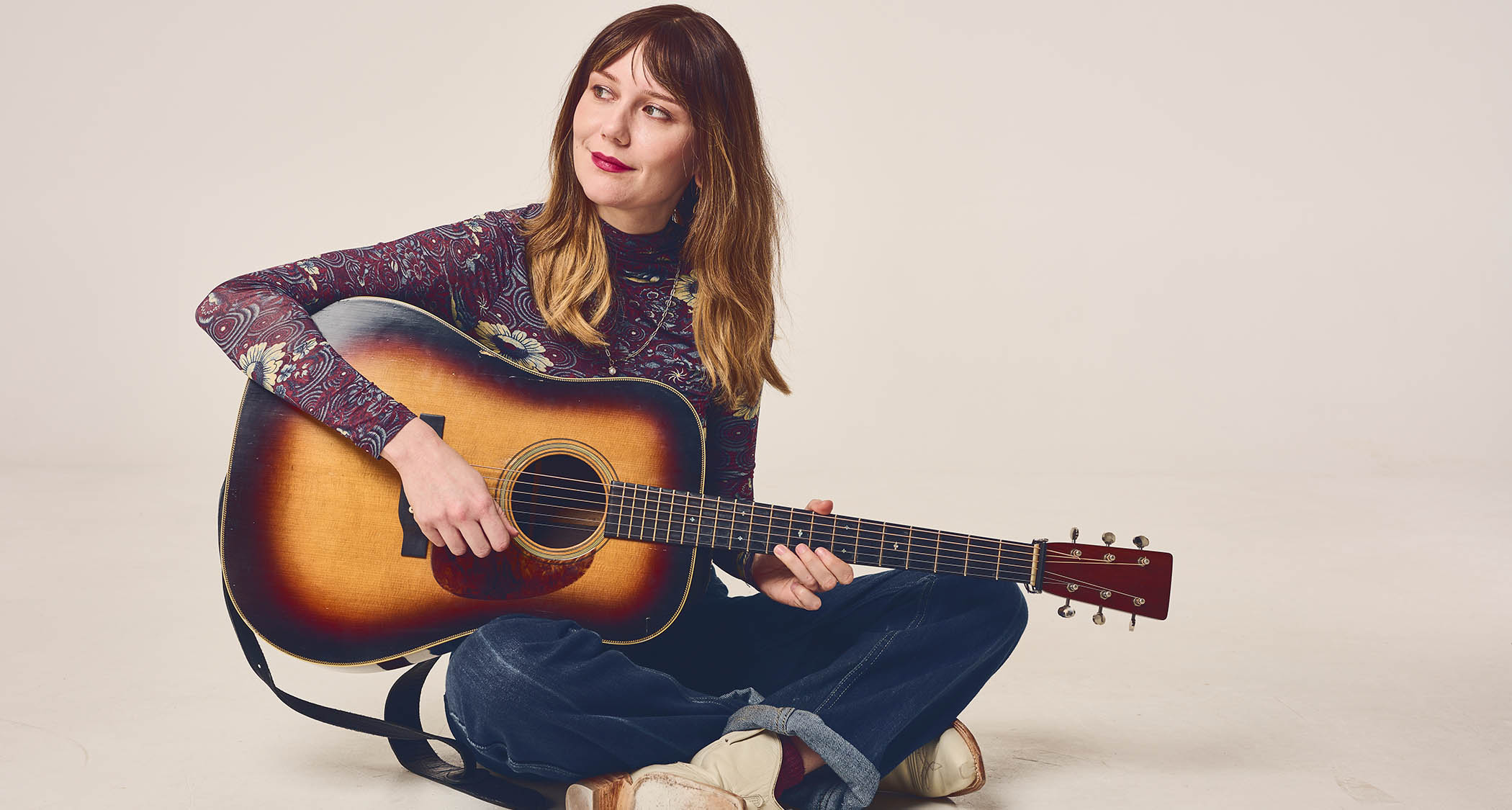“Bluegrass is friendly competition – who can play the fastest, who can play the hottest licks”: Molly Tuttle on training her brain to catch her fingers and the pursuit of speed, feel and acoustic guitar virtuosity
One of bluegrass's most gifted guitarists, Tuttle checks in to discuss the evolution of her style, and why it pays to subvert received wisdom and practice flat-out as fast as you can go

With strong songs, engaging storytelling and phenomenal technique, Molly Tuttle has established herself as bluegrass’s premier young talent. Her last two albums – 2022’s Crooked Tree and 2023’s City Of Gold - both won Grammys and she has twice been Bluegrass Guitarist of the Year, the first woman to win the title.
Tell us about the EP you have coming later this year…
“It’s called Into The Wild. I’ve been working on writing a whole new batch of songs, but Into The Wild felt more like a continuation of the last record. It has two new original songs on it with my bandmates in Golden Highway. There’s also a stripped down version of Stranger Things, a reworked song from our last record, City of Gold.
“Then we have a new cover of Here In California from Kate Wolf, one of my favourite California songwriters. “That’s a tribute to my musical upbringing. My dad sings on it, and also my friend AJ Lee, who used to sing with me when we were growing up. Then there are covers from the last couple years that haven’t officially been on any release yet: Jefferson Airplane’s White Rabbit and Olivia Rodriguez’s Good For You.”
In rock and metal, shredding can be divisive. Virtuoso bluegrass players don’t seem to get the same negative reactions. Why do you think that is?
“When I hear a heavy metal guitar player there is that raw emotion that can maybe sound a little angry, whereas I feel like bluegrass is more friendly competition – who can play the fastest, who can play the hottest licks or whatever. It’s on acoustic instruments and it is very happy sounding music, even if a lot of the songs have sad lyrics.
“It’s like folk music in that you can be a complete beginner and enter a jam circle, and as long as you know a handful of songs you’re okay. It is kind of an accessible music in that way. But then to get to playing on stage or being one of the prominent people in the genre you do have to work really hard because there’s that speed element and it’s a highly technical type of music.”
Get The Pick Newsletter
All the latest guitar news, interviews, lessons, reviews, deals and more, direct to your inbox!
It’s like folk music in that you can be a complete beginner and enter a jam circle, and as long as you know a handful of songs you’re okay
Even the fastest bluegrass lines are very melodic. How do you do that?
“You definitely do play to the chords a little bit more than other styles. Like when I went to Berklee, I couldn’t play very well over, like, jazz changes. But then I would meet jazz guitar players who are like, ‘Whoa, that’s so crazy! Every note you’re playing is in the chord, and you’re incorporating melody while playing fast!’
“It seems a lot more simple to me to just play over three major chords, but for people who are more used to playing modes over jazz changes, that was weird to them.”
How much of what you do is improvised?
“It depends if I’m playing my own set. When I’m playing a show, I have so much to think about. I tell stories between the songs. I want to make it an entertaining show, and I’m singing. So I do fall into similar solos, or at least I know I can fall back on a lick that I know will work, just because there’s so many other variables when I’m carrying the show.
I used to work stuff out for my albums, but recently I’ve started either totally improvising it using the take that I played in the studio
“But there are always songs in the set where I’m totally improvising. If we throw in a new song that we haven’t done before, then that’s completely improvised. Usually, if I’m playing with other people or sitting in, that’s all improvised.
“I used to work stuff out for my albums, but recently I’ve started either totally improvising it using the take that I played in the studio, or if I wasn’t happy with it, improvising takes until I get one I really like. Sometimes I’ll work it out in the studio. I’ll play a take and if I like part of it, I’ll try to play it again, and maybe save the good part from the take before, and flesh it out that way.”
Did it take a lot of trial and error to develop your technique?
“My dad was my first guitar teacher. I settled on my technique pretty early on because if I was holding the pick weirdly or doing it in a way that would mess things up for me later down the road, he would be like, ‘Here’s a better way.’ I didn’t spend a lot of time on it after those first couple years.”
Is there one accepted technique for bluegrass, or is there a lot of variety?
“There’s quite a bit. A lot of people are self-taught or learn from watching different guitar players and who all do it differently. Someone might study Tony Rice’s technique, or David Greer or Clarence White. Brian Sutton is someone who teaches a lot, and he holds the pick in a totally different way than I do.
“That works for him and will probably work for all his students, too. My technique is not exactly the same as my dad’s but pretty similar. There are a lot of people you’ll see anchor their ring finger and pinky finger on the guitar body. My fingers are more curled in and my wrist is resting on the guitar a little bit more.”
Did you struggle to develop your speed at all?
“Speed for me came more easily. I would practice with a metronome and just play faster and faster each day, try to push my speed to where sometimes I would play faster than I could really play it cleanly. After doing that, for a couple days, eventually my brain would kind of catch up with my fingers, and I would get faster.
Speed for me came more easily. I would practice with a metronome and just play faster and faster each day
“The thing I plateaued on was learning about the fingerboard, improvising, being able to play new ideas. Sometimes I’d get stuck playing the same things over and over again. I still feel like that sometimes, but now I just see it more as my style, like I have a sound that is my own.
“It’s okay if I play some of the same licks or play things that I gravitate towards, because that’s what I like. I didn’t know any music theory growing up. When I went to Berklee I finally learned the notes on the fingerboard and different scales, and worked on incorporating that. I was just playing by ear before that.”
That’s really interesting, because it’s the opposite of what many of us were taught.
“My dad would say, ‘You have to play a little faster than you can actually play if you ever want to get faster.’ He had so many students who would hit that plateau of like, ‘Oh, I’m afraid to play any faster than this,’ and they would just never gain any speed. I think in a way he was experimenting with me and my brothers, like, ‘What if I have them play these pieces extremely fast – to where they sound super-messy at first?’
The only way to practice something fast is to practice it where you can’t actually play it very well
“It did work. We would practice something super, super-fast to a metronome, and push it past our abilities. That really helped us gain speed over time. I guess he had the idea of, ‘Well, if you are always practicing slow, then you’re not going to ever practice things fast.’ The only way to practice something fast is to practice it where you can’t actually play it very well.
“But it’s great to practice things slow, too. If there’s one little three- or four-note section that you can’t do up to speed, then play that tiny little section slowly, figure out what’s going on, and troubleshoot it, instead of just practicing the entire thing. It’s important to be super-effective with figuring out what what’s actually holding you back.”
Are there any secrets to playing fast?
“I’ve arranged whole guitar pieces that took me a long time to get up to speed or, but I realised that with a lot of my favourite guitar players, their playing isn’t really like that. They find things that sound complicated, but they’re actually easy to play.
“I think that’s really an art in itself to find things that are secretly simple, but sound like, ‘Wow! How do they do that?’ Like David Greer’s solos – they’re hot. They are hard to play. But I’m always surprised at how much easier it is to actually play them than it sounds. He’s so good at finding things that you can play really fluidly.”
You have to bring up the volume, which makes it harder to play clean and fast
Most players get lighter as they get faster. How do you maintain the power?
“That’s one of the big struggles of acoustic guitar flatpicking. I feel like the fast songs are when you need to play your loudest. When you play a fast bluegrass song, everyone’s playing as loud and as hard as they can, and the guitar’s the quietest instrument.
“You have to bring up the volume, which makes it harder to play clean and fast. I use an incredibly heavy pick. Even other guitarists I talk to who play similar styles are like, ‘Whoa, I couldn’t ever play with that!’ I use these Dunlop 208 Jazztone picks.”
Your clawhammer technique uses aggressive downstrokes with the backs of your fingernails. Do you have to do anything to protect them?
“It wears them down a bit, but I don’t really do anything because I’m not sitting around playing that way for hours a day. Usually in the show we’ll do one or two songs. Sometimes we work up a new clawhammer song and I might be playing that a few times throughout the day, but usually when I’m warming up I’m flatpicking.
“I just feel like the clawhammer style for me is ingrained. I don’t need to sit around practicing it all day. If that were my main style I would probably have to do something about my nails. One or two times I’ve had a tear in a cuticle or a little cut on my finger, but it wasn’t a disaster.”

Tell us about the dreadnought you play.
“Yeah, that’s my main guitar on the cover of City of Gold. It’s from Pre-War Guitars Company, made in North Carolina. They take these old 1930s Martins and Gibsons and model their guitars after them.
“They make them like the old guitars with just a few changes, like mine has a truss rod so I can adjust it on the road. That’s the perfect balance for me. It sounds a little bit like an older guitar, but it’s a lot more road-friendly. I just started using it on my records, too, because I really liked how it sounds and it’s the guitar I’m the most used to playing. It’s the one I played on most of City of Gold and the new tracks.”
I guess 90 or 95 per cent of bluegrass guitar players are playing a dreadnought. It really cuts through the band, and it’s pretty resonant and takes up a lot of space
Is a dreadnought the bluegrass standard, would you say?
“Yeah, basically everyone plays one. Occasionally, you’ll see people pull out a 000. I guess 90 or 95 per cent of bluegrass guitar players are playing a dreadnought. It really cuts through the band, and it’s pretty resonant and takes up a lot of space, which is good when you’re playing with four instruments that are a little louder than you.”
Do you use lighter acoustic guitar strings or a low action to help with playing fast?
“I use medium [13 gauge] strings, but I do keep my action pretty low. I’ve experimented with light strings, but I find that when I’m playing hard it just gets too buzzy and thin. The struggle for me is I really like when my action’s low, but if it gets too low, then I get the same buzzy-ness. I have to keep it somewhere in the middle.
“By bluegrass standards, I keep mine pretty low because there’s this macho thing like, ‘We got to have high action and we have to use these heavy strings!’”
How do you get a good amplified acoustic tone?
“I go through so many different things to try to get the tone I want. Pretty much the one thing I’ve used for the past few years is my Grace Audio Felix preamp. It doesn’t add a whole lot of tone, but there’s a lot of different options with it and it has two channels that worked when I was using two different pickups.
“Now I have the LR Baggs HiFi pickup and they’ve now installed a little mic in it. It’s still going through one line, but inside the guitar I can adjust how much mic I want to use. I struggle with the internal mic. It sounds good but since it’s inside the guitar, me moving the guitar at all on my shirt is really loud. So we’ve turned down the mic and we just use a little bit of it.
“I’m running it through a Fishman Aura. Fishman modelled my guitar through all these mics, and it’s supposed to take my pickup and model it after my guitar being played through mic. It’s not perfect. I hear back sometimes and I’m like, ‘That sounds like a pickup.’ But it’s better than nothing.”
- Into the Wild is scheduled for release in October.
Jenna writes for Total Guitar and Guitar World, and is the former classic rock columnist for Guitar Techniques. She studied with Guthrie Govan at BIMM, and has taught guitar for 15 years. She's toured in 10 countries and played on a Top 10 album (in Sweden).
“There’d been three-minute solos, which were just ridiculous – and knackering to play live!” Stoner-doom merchants Sergeant Thunderhoof may have toned down the self-indulgence, but their 10-minute epics still get medieval on your eardrums
“There’s a slight latency in there. You can’t be super-accurate”: Yngwie Malmsteen names the guitar picks that don’t work for shred









![A black-and-white action shot of Sergeant Thunderhoof perform live: [from left] Mark Sayer, Dan Flitcroft, Jim Camp and Josh Gallop](https://cdn.mos.cms.futurecdn.net/am3UhJbsxAE239XRRZ8zC8.jpg)







